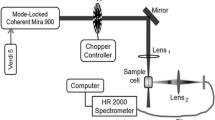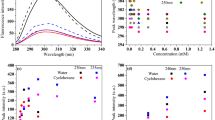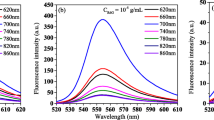Abstract
Effect of solution pH on two-photon absorption cross-section of highly fluorescent Coumarin and Rhodamine dyes with high repetition rate femtosecond laser pulses at 780 nm is presented using two-photon induced fluorescence technique. A correspondence in the measured two-photon and single-photon cross-section values is seen when the pH changes from acidic to basic conditions (pH = 2–10) for solutions in 1:1 water-ethanol binary mixture. By plotting changes in the single-photon and two-photon fluorescence in this pH range, the excited state pKa values are found. The ground state pKa values are also affected by the protonation deprotonation equilibrium as a result of variation in pH from acidic to basic, which are characterized by changes in absorbance spectra. Most of these single-photon and two-photon induced fluorescence spectra show characteristic blue shifts. Different fluorescence quantum yields calculated at each pH reflect a change in structure corresponding to their associated properties as a result of acid base equilibrium.















Similar content being viewed by others
References
Göppert-Mayer M (1931) Elementary processes with two quantum transitions. Ann Phys 9(401):273–294
Kaiser W, Garrett C (1961) Two-photon excitation in CaF2: Eu2+. Phys Rev Lett 7:229–231
Denk W, Strickler JH, Webb WW (1990) Two-photon laser scanning fluorescence microscopy. Science 248(4951):73–76
Piston DW, Masters BR, Webb WW (1995) Three-dimensionally resolved NAD(P)H cellular metabolic redox imaging of the in situ cornea with two-photon excitation laser scanning microscopy. J Microsc 178:20–27
Xu C, Zipfel W, Shear JB, Williams RM, Webb WW (1996) Multiphoton fluorescence excitation: new spectral windows for biological nonlinear microscopy. Proc Natl Acad Sci 93:10763–10768
Sheppard C, Gu M (1990) Image formation in two-photon fluorescence microcopy. Optik (Stuttg) 86(3):104–106
Wei P, Tan OF, Zhu Y, Duan GH (2007) Axial superresolution of two-photon microfabrication. Appl Opt 46(18):3694–3699
Leatherdale CA, DeVoe RJ (2003) Two-photon microfabrication using two-component photoinitiation systems: effect of photosensitizer and acceptor concentrations. Proc SPIE 5211:112–123
Teh WH, Dürig U, Salis G, Harbers R, Drechsler U, Mahrt RF, Smith CG, Güntherodt H-J (2004) SU-8 for real three-dimensional subdiffraction-limit two-photon microfabrication. Appl Phys Lett 84:4095–4097
Mendonca CR, Cerami LR, Shih T, Tilghman RW, Baldacchini T, Mazur E (2008) Femtosecond laser waveguide micromachining of PMMA films with azoaromatic chromophores. Opt Express 16(1):200–206
Correa DS, Cardoso MR, Tribuzi V, Misoguti L, Mendonca CR (2012) Femtosecond laser in polymeric materials: microfabrication of doped structures and micromachining. IEEE J Sel Top Quantum Electron 18(1):176–186
He GS, Gvishi R, Prasad PN, Reinhardt BA (1995) Two-photon absorption based optical limiting and stabilization in organic molecule-doped solid materials. Opt Commun 117:133–136
He GS, Xu GC, Prasad PN, Reinhardt BA, Bhatt JC, Dillard AG (1995) Two-photon absorption and optical-limiting properties of novel organic compounds. Opt Lett 20(5):435–437
He GS, Bhawalkar JD, Zhao CF, Prasad PN (1995) Optical limiting effect in a two-photon absorption dye doped solid matrix. Appl Phys Lett 67:2433–2435
Zhao PD, Chen P, Tang GQ, Zhang GL, Chen WJ (2004) Two-photon spectroscopic properties of a new chlorin derivative photosensitizer. Chem Phys Lett 390:41–44
Fisher WG, Partridge WP, Dees C, Wachter EA (1997) Simultaneous two-photon activation of type-I photodynamic therapy agents. Photochem Photobiol 66:141–155
Tsiminis G, Ribierre J-C, Ruseckas A, Barcena HS, Richards GJ, Turnbull GA, Burn PL, Samuel IDW (2008) Two-photon absorption and lasing in first-generation bisfluorene dendrimers. Adv Mater 20:1940–1944
Albota M, Beljonne D, Brédas JL, Ehrlich JE, Fu JY, Heikal AA, Hess SE, Kogej T, Levin MD, Marder SR, McCord-Maughon D, Perry JW, Röckel H, Rumi M, Subramaniam G, Webb WW, Wu XL, Xu C (1998) Design of organic molecules with large two-photon absorption cross sections. Science 281:1653–1656
Kogej T, Beljonne D, Meyers F, Perry JW, Marder SR, Brédas JL (1998) Mechanisms for enhancement of two-photon absorption in donor–acceptor conjugated chromophores. Chem Phys Lett 298:1–6
Cho BR, Son KH, Lee SH, Song Y-S, Lee Y-K, Jeon S-J, Choi JH, Lee H, Cho M (2001) Two photon absorption properties of 1,3,5-tricyano-2,4,6-tris(styryl)benzene derivatives. J Am Chem Soc 123:10039–10045
Kannan R, He GS, Lin TC, Prasad PN, Vaia RA, Tan LS (2004) Toward highly active two-photon absorbing liquids. Synthesis and characterization of 1,3,5-triazine-based octupolar molecules. Chem Mater 16:185–194
Beljonne D, Wenseleers W, Zojer E, Shuai Z, Vogel H, Pond SJK, Perry JW, Marder SR, Brédas JL (2002) Role of dimensionality on the two-photon absorption response of conjugated molecules: the case of octupolar compounds. Adv Funct Mater 12:631–641
Chung S-J, Kim K-S, Lin T-C, He GS, Swiatkiewicz J, Prasad PN (1999) Cooperative enhancement of two-photon absorption in multi-branched structures. J Phys Chem B 103:10741–10745
Bhaskar A, Ramakrishna G, Lu Z, Twieg R, Hales JM, Hagan DJ, Van Stryland E, Goodson T (2006) Investigation of two-photon absorption properties in branched alkene and alkyne chromophores. J Am Chem Soc 128:11840–11849
Kim HM, Cho BR (2009) Two-photon materials with large two-photon cross sections. Structure–property relationship. Chem Commun:153–164
Drobizhev M, Karotki A, Dzenis Y, Rebane A, Suo Z, Spangler CW (2003) Strong cooperative enhancement of two-photon absorption in dendrimers. J Phys Chem B 107:7540–7543
Charlot M, Izard N, Mongin O, Riehl D, Blanchard-Desce M (2006) Optical limiting with soluble two-photon absorbing quadrupoles: structure–property relationships. Chem Phys Lett 417:297–302
Wang C-K, Zhao K, Su Y, Ren Y, Zhao X, Luo Y (2003) Solvent effects on the electronic structure of a newly synthesized two-photon polymerization initiator. J Chem Phys 119:1208–1213
Luo Y, Norman P, Macak P, Agren H (2000) Solvent-induced two-photon absorption of a push − pull molecule. J Phys Chem A 104:4718–4722
Kim HM, Lee YO, Lim CS, Kim JS, Cho BR (2008) Two-photon absorption properties of alkynyl-conjugated pyrene derivatives. J Org Chem 73:5127–5130
De Boni L, Misoguti L, Zílio SC, Mendonça CR (2005) Degenerate two-photon absorption spectra in azoaromatic compounds. Chem Phys Chem 6:1121–1125
Varnavski O, Yan X, Mongin O, Blanchard-Desce M, Goodson T (2007) Strongly interacting organic conjugated dendrimers with enhanced two-photon absorption. J Phys Chem C 111:149–162
Frediani L, Rinkevicius Z, Agren H (2005) Two-photon absorption in solution by means of time-dependent density-functional theory and the polarizable continuum model. J Chem Phys 122:244104
Woo HY, Liu B, Kohler B, Korystov D, Mikhailovsky A, Bazan GC (2005) Solvent effects on the two-photon absorption of distyrylbenzene chromophores. J Am Chem Soc 127:14721–14729
Fitilis I, Fakis M, Polyzos I, Giannetas V, Persephonis P, Vellis P, Mikroyannidis J (2007) A two-photon absorption study of fluorene and carbazole derivatives. The role of the central core and the solvent polarity. Chem Phys Lett 447:300–304
Yan Y, Li B, Liu K, Dong Z, Wang X, Qian S (2007) Enhanced two-photon absorption and ultrafast dynamics of a new multibranched chromophore with a dibenzothiophene core. J Phys Chem A 111:4188–4194
Zhou Y, Miao Q, Sun Y-P, Gel’mukhanov F, Wang C-K (2011) Solvent effect on dynamical TPA and optical limiting of BDMAS molecular media for nanosecond and femtosecond laser pulses. J Phys B Atomic Mol Phys 44:35103
Wielgus M, Bartkowiak W, Samoc M (2012) Two-photon solvatochromism. I. Solvent effects on two-photon absorption cross section of 4-dimethylamino-4′-nitrostilbene (DANS). Chem Phys Lett 554:113–116
Alam MM, Chattopadhyaya M, Chakrabarti S, Ruud K (2012) High-polarity solvents decreasing the two-photon transition probability of through-space charge-transfer systems - a surprising in silico observation. J Phys Chem Lett 3:961–966
Murugan NA, Chakrabarti S, Ågren H (2011) Solvent dependence of structure, charge distribution and absorption spectrum in the photochromic merocyanine- spiropyran pair. J Phys Chem B 115:4025–4032
Leng W, Bazan GC, Kelley AM (2009) Solvent effects on resonance Raman and hyper-Raman scatterings for a centrosymmetric distyrylbenzene and relationship to two-photon absorption. J Chem Phys 130:044501
Rumi M, Perry JW (2010) Two-photon absorption: an overview of measurements and principles. Adv Opt Photon 2:451
Xu C, Webb WW (1997) Top Fluoresc Spectrosc. In: Lakowicz JR (ed) Plenum Press, New York, 5:471–540
Sutherland RL (2003) Handbook of nonlinear optics, 2nd Ed. CRC Press, Boca Raton, FL, USA
Yang H, Zhuang YM, Hu H, Du XX, Zhang CX, Shi XY, Wu HX, Yang SP (2010) Silica-coated manganese oxide nanoparticles as a platform for targeted magnetic resonance and fluorescence imaging of cancer cells. Adv Funct Mater 20:1733–1741
Zhou K, Wang Y, Huang X, Luby-Phelps K, Sumer BD, Gao J (2011) Tunable ultrasensitive pH-responsive nanoparticles targeting specific endocytic organelles in living cells. Angew Chem Int Ed 50:6109–6114
Koide Y, Urano Y, Hanaoka K, Terai T, Nagano T (2011) Evolution of group 14 rhodamines as platforms for near-infrared fluorescence probes utilizing photoinduced electron transfer. ACS Chem Biol 6:600–608
Li Z, Wu S, Han J, Han S (2011) Imaging of intracellular acidic compartments with a sensitive rhodamine based fluorogenic pH sensor. Analyst 136:3698–3706
Yuan L, Lin W, Feng Y (2011) A rational approach to tuning the pKa values of rhodamines for living cell fluorescence imaging. Org Biomol Chem 9:1723–1726
Slavik J (1994) Fluorescent probes in cellular and molecular biology. CRC-Press, Boca Raton, FL, USA
Reichardt C (1994) Solvatochromic dyes as solvent polarity indicators. Chem Rev 94:2319–2358
Lakowicz J R (2006) Principles of fluorescence spectroscopy, 3rd edition, Springer, New York
Batistela VR, Pellosi DS, de Souza FD, da Costa WF, de Oliveira SSM, de Souza VR, Caetano W, de Oliveira HPM, Scarminio IS, Hioka N (2011) pKa determinations of xanthene derivates in aqueous solutions by multivariate analysis applied to UV–Vis spectrophotometric data. Spectrochim Acta A Mol Biomol Spectrosc 79:889–897
Pandey MM, Jaipal A, Kumar A, Malik R, Charde SY (2013) Determination of pKa of felodipine using UV-visible spectroscopy. Spectrochim Acta A 115:887–890
Best QA, Xu R, McCarroll ME, Wang L, Dyer DJ (2010) Design and investigation of a series of rhodamine-based fluorescent probes for optical measurements of pH. Org Lett 12:3219–3221
Vasylevska AS, Karasyov AA, Borisov SM, Krause C (2007) Novel coumarin-based fluorescent pH indicators, probes and membranes covering a broad pH range. Anal Bioanal Chem 387:2131–2141
Xu C, Webb WW (1996) Measurement of two-photon excitation cross sections of molecular fluorophores with data from 690 to 1050 nm. J Opt Soc Am B 13:481–491
Wakebe T, Keuren EV (1999) The excitation spectra of two-photon induced fluorescence in xanthene dyes. Jpn J Appl Phys 38:3556–3561
Arbeloa FL, Arbeloa TL, Estévez MJT, Arbeloa IL (1991) Photophysics of rhodamines: molecular structure and solvent effects. J Phys Chem 95:2203–2208
Karton-Lifshin N, Presiado I, Erez Y, Gepshtein R, Shabat D, Huppert D (2012) Ultrafast excited-state intermolecular proton transfer of cyanine fluorochrome dyes. J Phys Chem A 116:85–92
Jones G, Jimenez JAC (2001) Azole-linked coumarin dyes as fluorescence probes of domain-forming polymers. J Photochem Photobiol B Biol 65:5–12
Druzhinin SI, Bursulaya BD, Uzhinov BM (1993) Kinetics and mechanism of photoprotonation of coumarin-102 by sulfuric acid in ethanol. J Appl Spectrosc 59:653–658
Albert A, Serjeant EP (1962) Ionisation constants of acids and bases. Methuen & Co Ltd., London
Singh S, Sharda N, Mahajan L (1999) Spectrophotometric determination of pKa of nimesulide. Int J Pharma 176:261–264
Batistela VR, Pellosi DS, de Souzaa FD, da Costa WF, de O Santin SM, de Souzaa VR, Caetano W, de Oliveira HPM, Scarminio IS, Hioka N (2011) pKa determinations of xanthene derivates in aqueous solutions by multivariate analysis applied to UV–Vis spectrophotometric data. Spectrochim Acta A 79:889–897
Batistela VR, Cedran JC, Oliveira HPM, Scarmino IS, Ueno LT, Machado AEH, Hioka N (2010) Protolytic fluorescein species evaluated using chemometry and DFT studies. Dyes Pigments 86:15–24
Baki CN, Akkaya EU (2001) Boradiazaindacene- appended calix[4]arene: fluorescence sensing of pH near neutrality. J Org Chem 66:1512–1513
Saleh N, Rawashdeh AMM, Yousef YA, Al-Soud YA (2007) Structural charecterization of new Cd2+ fluorescent sensor based on lumazine ligand: AM1 and ab initio studies. Spectrochim Acta A 68:728–733
Pazos IM, Ahmed IA, Berrios MIL, Gai F (2015) Sensing pH via p-cyanophenylalanine fluorescence: application to determine peptide pKa and membrane penetration kinetics. Anal Biochem 483:21–26
Callis PR (1997) Two photon induced fluorescence. Ann Rev Phys Chem 48:271–297
Makarov NS, Drobizhev M, Rebane A (2008) Two-photon absorption standards in the 550–1600 nm excitation wavelength range. Opt Express 16:4029–4047
Beija M, Afonso CAM, Martinho JMG (2009) Synthesis and applications of rhodamine derivatives as fluorescent probes. Chem Soc Rev 38:2410–2433
Kelley A M (2012) Condensed-phase molecular spectroscopy and Photophysics. John Wiley & Sons, Inc., Hoboken, NJ, USA. doi:10.1002/9781118493052.ch8
Guthmuller J, Champagne B (2008) Resonance Raman scattering of rhodamine 6G as calculated by time-dependent density functional theory: vibronic and solvent effects. J Phys Chem A 112:3215–3223
Heimel G, Daghofer M, Gierschner J, List EJW, Grimsdale AC, Müllen K, Beljonne D, Brédas J-L, Zojer E (2005) Breakdown of the mirror image symmetry in the optical absorption/emission spectra of oligo(Para-phenylene)s. J Chem Phys 122:54501
Grabowski Z (2003) R, Rotkiewicz K, Rettig W, structural changes accompanying intramolecular electron transfer: focus on twisted intramolecular charge-transfer states and structures. Chem Rev 103:3899–4031
Dash N, Chipem FAS, Swaminathan R, Krishnamoorthy G (2008) Hydrogen bond induced twisted intramolecular charge transfer in 2-(4′-N,N-dimethylaminophenyl)imidazo[4,5-b]pyridine. Chem Phys Lett 460:119–124
Soujanya T, Fessenden RW, Samanta A (1996) Role of nonfluorescent twisted intramolecular charge transfer state on the photophysical behavior of aminophthalimide dyes. J Phys Chem 100:3507–3512
Stsiapura VI, Maskevich AA, Kuzmitsky VA, Turoverov KK, Kuznetsova IM (2007) Computational study of Thioflavin T torsional relaxation in the excited state. J Phys Chem A 111:4829–4835
Acknowledgments
DG thanks MHRD, DST and ISRO (Govt. of India) for funding. KM thanks UGC Govt. of India for Graduate fellowship.
Author information
Authors and Affiliations
Corresponding author
Rights and permissions
About this article
Cite this article
Makhal, K., Goswami, D. pH Effect on Two-Photon Cross Section of Highly Fluorescent Dyes Using Femtosecond Two-Photon Induced Fluorescence. J Fluoresc 27, 339–356 (2017). https://doi.org/10.1007/s10895-016-1963-4
Received:
Accepted:
Published:
Issue Date:
DOI: https://doi.org/10.1007/s10895-016-1963-4




